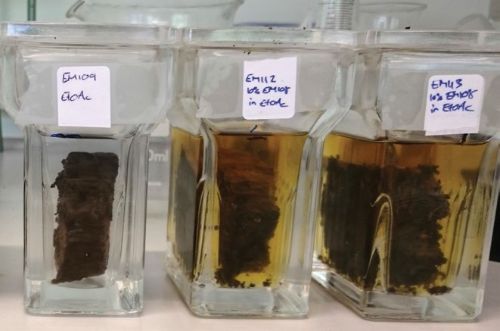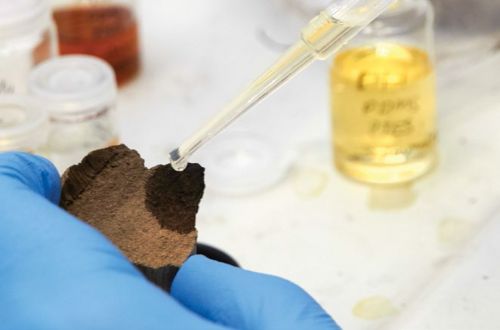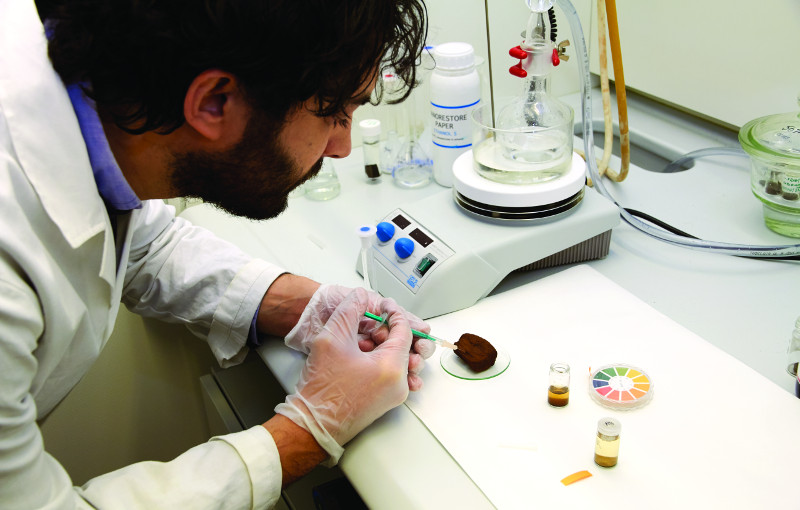Existing consolidants may not be compatible for some Oseberg objects. Considering the immense development of material science during last decades, Saving Oseberg decided to dedicate a part of its capacity to develop materials that better suit the needs of these artifacts, and is aiming to:
- use bio-polymers, preferably wood components or their derivatives (‘Green Chemistry’)
- functionalize the molecules in a way that they form a network that consolidates the wood, controls pH and traps metal ions, thereby stabilizing the object
- maintain an open structure inside the object, leaving structural space for future re-treatment and without removing previously applied conservation material
After evaluating several possibilities, the project is focussing on three types of materials:
Lignin
 Lignin is one of the major components of wood. The lignin network protects the cellulose in the cell wall from chemical attack and is chemically very stable. One part of the project has therefore focused on using materials similar to lignin to consolidate degraded wood. Lignin itself is a polymer, which means it is a large molecule built up of many units and is too big to penetrate wood. Therefore research has looked at making smaller lignin-like materials that can impregnate the wood. These are under development, but early results are promising, showing that the materials penetrate archaeological wood well and offer some structural stabilization.
Lignin is one of the major components of wood. The lignin network protects the cellulose in the cell wall from chemical attack and is chemically very stable. One part of the project has therefore focused on using materials similar to lignin to consolidate degraded wood. Lignin itself is a polymer, which means it is a large molecule built up of many units and is too big to penetrate wood. Therefore research has looked at making smaller lignin-like materials that can impregnate the wood. These are under development, but early results are promising, showing that the materials penetrate archaeological wood well and offer some structural stabilization.
Polysaccharides 
Polysaccharides are a class of polymers that include cellulose, a major component of wood, and chitosan, derived from the structural material in crustacean shells. Research on chitosan has so far shown that it has some potential for consolidating degraded wood, but ongoing work is looking at making smaller chitosan-like molecules that are more soluble and able penetrate wood better. Certain types of modified celluloses are also being investigated to see if they could be potential consolidants.
Siloxanes
Siloxanes belong to a class of compounds containing silicon connected to an organic network. They can create short, long or complex polymer particles with excellent mechanical properties, and have therefore been used for industrial and medical applications, and, with great success, in stone conservation. Since siloxanes are able to form flexible 3-dimensional networks that can interact with the accessible chemical groups in wood, they have recently been applied to waterlogged wood consolidation, and certain types are being investigated for the Oseberg case.
Alkaline nanoparticles modified with siloxanes
High acidity is thought to be a major reason for wood decay in the artefacts. The wood therefore needs to be de-acidified as well as structurally supported. Alkaline nanoparticles, well known for neutralizing acidic paper, were investigated for their effectiveness on highly degraded Oseberg wood. Results so far have shown that calcium hydroxide nanoparticles are a promising material to raise the pH of the alum-treated wood. Further work is looking at incorporating these nanoparticles into a 3-dimensional network with flexible siloxanes, in order to make a material that can de-acidify and consolidate the objects in one step.